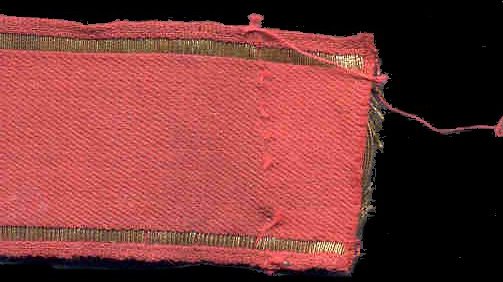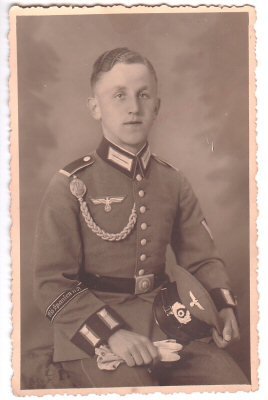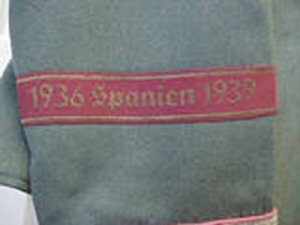
By COL Scott Pritchett
On 3 June 1939, members of the German Army (Heer) who had performed service in the Spanish Civil War were honored in a ceremony hosted by the Commander in Chief of the Army (Oberbefehlshaber des Heeres), General von Brauchitsch. The ceremony took place on the famed parade field at Doberitz. The men standing on the field that day had formed the Army contingent to the ’Legion Condor’. Having just returned from Spain, entering the port of Hamburg on 30 May 1939, following a victory parade in Madrid, as well as an official welcome back to Germany by Reichsmarshall Hermann
Göring, these men were now to be recognized by their own arm of service.
Earlier, Göring had announced that the Fürher had created a special award badge for the Condor “legionnaires”.
This, of course, is what collectors know as the Spanish Cross. As the Luftwaffe had made up the bulk of the Condor Legion, the award took on characteristics that left no doubt as to the preeminent role the flyers played in the three-year effort on behalf of Franco and his Nationalists.
The Legion Condor, conceived in July 1936 as a small air transport detachment on loan for the express purpose of transporting Franco’s Nationalist Army stranded in Spanish Morocco, had grown substantially by early 1937 to include all arms of the Wehrmacht (except the Waffen SS). In addition to the large Luftwaffe contingent, the Legion Condor also included a
Kriegsmarine group – the Legion Condor “North Sea Group”- comprised of a staff, technicians and two pocket battleships, as well as an Army group, called simply “Gruppe Imker” (beekeepers). The Imker (or “Drohne” as it was also referred to by its code name) at its height was comprised of three Panzer (tank) Kompanien, a Nachshub/Transport (Supply/Transport) Kompanie, and a Nachrichten (Signals) Kompanie. Its initial commander was Oberstleutnant Walter Warlimont of the German General Staff. However, its later commander, and the one most associated with “Drohne”, became Oberst von Thoma.
In addition to awarding participants the Spanish Cross in one of its seven versions, the name “Legion
Condor” and its honors/traditions were also to be preserved within the Luftwaffe by the awarding of a traditions cufftitle – “Legion Condor”. The traditions were bestowed to a squadron of bombers, a flak artillery regiment and a signals detachment. While it can be assumed that all participants, regardless of arm of service, who met the criteria for the Spanish Cross received an badge, it was a logical consequence of both the
Luftwaffes' actions in establishing its traditions cufftitle, as well as longstanding practice (dating back to the late 1700s) of bestowing traditions cufftitles within the German Army, that the Heer should also bestow similar recognition of its service. Consequently, by an order dated 21 June 1939, Heeresverordnungsblatt 39B/262, the Commerative Cufftitle for the Imker-Verbande was established. The units selected to carry the traditions cufftitle were the Panzer-Lehr-Regiment, the Nachrichten-Lehr Regiment, and the Versuchs-Abteilung (Experimental Battalion). It was at the ceremony at Doberitz that von Brauchitsch presented these three units with the traditions
cufftitle.
General Description:
The cufftitle features a madder red, or Kapprot, background with a metallic gold thread machine woven inscription “1936 Spanien 1939” in an old style calligraphy. The entire length of the cufftitle is bordered top and bottom by a machine woven border in the same gold metallic thread. This border sets in slightly from the outer edge of the cufftitle. The colors that make up the cufftitle reflect Spain’s national colors or red and gold. For this reason alone, the cufftitle is unique among Third Reich cufftitles, which otherwise usually are confined to blacks, silvers, dark blues, dark greens, whites or browns – although Heer cufftitles tend to display a wider variance in color selection than do the other services. It is interesting to note that Spain only adopted the red and gold colors as national colors at the end of the Spanish Civil War. It should also be noted here that the term ‘cufftitle’ is an English language generalization for two types of insignia that were defined in the German military by the terms Armelstreifen (stripes), and Armelbander (bands). It is only the cufftitles bestowed as campaign or battle awards that qualify as ‘bands’. As a commemorative award, the Spanish Civil War title is technically an Armelstreifen although it can also be found referred to in reference books categorized as a “campaign cuffband”, as it is a rather unique cross between the two.

Detailed Description of Characteristics:
The “1936 Spanien 1939” cufftitle is an exceedingly rare item for the
collector. There is little if any solid evidence that it was manufactured in
more than one style. Additionally, due to its unique styling, very likely
limited production, narrow issuance, restrictive wear regulations, and
short-lived significance as a battle or traditions decoration prior to the war –
a war that saw a plethora of other cufftitles and cuffbands instituted - any
variations from what is described here, as a rule should be very carefully
considered as being a post war reproduction. Its rarity is an advantage to
collectors, as most encountered will be reproductions or fakes.
Obverse: The German kapprot color of the cufftitle is a madder red. Madder, an old world dye from the root of the Eurasian Madder plant, is distinct among the other reds used by the Wehrmacht. Some sources variously will refer to it as a bright red or wine red, but it is a deeply toned, medium red, with an almost ‘royal’ quality to it. The material on which the title is machine woven is a high quality, single ply cotton fabric. Upon close inspection (under magnification), one will observe two distinct weave patterns within the fabric. The center of the band, that is the portion containing the woven lettering, has a distinct diagonal weave running from upper left to lower right. The second weave pattern is featured on the outer edges. Here one observes a cross-hatching weave very similar to the effect seen in waffenfarbe pipings used on Third Reich Heer silk-rayon insignia. The reason for the different weaves appears two-fold. Fist, the cotton band required finishing on the edges so as not to unravel. Secondly, it is from these edges that the gold wire thread of the lettering anchors on the reverse and the gold wire woven line of the top and bottom borders are also contained within this 4mm wide cross-hatching.

The regulation states a width of 32mm, however with 50 years of moisture and
aging, cotton shrinks. Consequently, one should expect to see from between 30mm
– 32mm in width. A measurement greater than 32mm would be grounds for very
careful consideration. The cufftitle will have a starched feel to it, a product
of the combined effects of aging to the cotton and gold wire thread. However, it
is a supple article of cloth and if hung over the index finger, should readily
go limp. While these cufftitles were manufactured and cut from rolls for issue,
an approximate full length would be about 40-45 cm. Since it was authorized for
wear on the greatcoat, it would be feasible to find slightly longer lengths. The
example shown is 36 cm. and shows signs of having been sewn on, with the ends
trimmed and folded under.
The cotton band was finished on the edges with gold metallic thread woven bands
2mm in width. The thread, due to aging, will appear a tarnished gold today. Any
specimen with something other than gold metallic thread is most likely a
reproduction. The bordering lines are inset from the edges another 2mm. The
weave of the border lines is vertical and tightly done. Under magnification,
they should appear to be well imbedded in the cotton cloth.
The lettering “1936 Spanien 1939” is of an old style calligraphy, similar to old
English or Gothic text. The letters are woven into the cotton in the same
metallic gold thread and, due to the lettering style, vary individually in
height when measuring from highest point to lowest point as shown below:
1 – 15mm
9 – 14mm
3- 13mm
6 – 15mm
S- 18mm
p- 15mm
a- 10mm
n- 10mm
i- 14mm
e-10mm
The weave again is tight, only this time displays a waffle pattern. The spacing between the letters is uniform between any two adjacent letters (or numbers) in the same word. This space should measure 1mm. The spacing between word and dates is 5mm between the ‘6’ and the capital ‘S’ and 4mm between the lower case ‘n’ and the ‘1’. The overall length of the text of the cufftitle is 14.1 cm.

Reverse: The first impression one has when looking at the reverse of an original “1936 Spanien 1939” cufftitle is that the title, itself appears in reverse negative. In other words, the gold lettering of the obverse/front is now appears as red cotton. Setting off the letters in this manner are the gold metallic threads, which on the obverse, form the background. These gold metallic threads run vertically and almost the full length of the cufftitle. They are secured (machine woven) into the red base cloth only at the top and bottom approximately 4mm from the edge where they enter or depart from front to back or visa versa. Otherwise these threads are loose and appear wavy, slightly distorting the negative images of the lettering.

This negative image however, does not apply to the gold borders on top and bottom of the band. These remain gold, but are not mirror images as they appear on the obverse/front. The reverse construction of the bordering lines is unique. The measurement from the top or bottom of the gold metallic threads that form the title lettering to the edge of the band is 4mm. Working from the inside outward, the red cotton base cloth measures approximately 2mm. Next is a 1mm wide series of gold metallic thread loops, running verticle the full length of the cufftitle. Another 1mm of red cotton base cloth is exposed and completes the distance remaining to the edge of the band. This 1mm of base cloth exhibits the same cross-hatching as seen on the front edges.
Issue and Wear
No documentation surfaced by way of this research that would
establish the number issued to each recipient authorized to wear the cufftitle.
Its use was rather restrictive, being authorized only for the uniform coat
(meaning overcoat but also possibly the service blouse), the parade and dress
uniforms (same uniform, but differentiated by the being graded for wear) and the
ornamented coat/piped blouse. This information is recorded in the authorizing
order and would indicate a more formal intent for wear presentation. Also, given
the nature of the demonstration (Lehr) units authorized to wear the cuffband,
this seems to make sense. Therefore, it can be reasonably assumed that members
of the designated traditions units received one for every uniform they were
required to maintain and for which it was authorized. Thus, at least two and
possibly three, with officers possibly having requirements for as many as five
would be a fairly accurate conclusion. Coming as it did in mid-1939 with the
invasion of Poland months away and that it was only authorized for roughly two
small regiments, production was probably not extensive, nor would the award have
been widely recognized.

Photographic evidence of it in wear is exceedingly rare, but a couple
current of references do show photographs. However, by regulation it was to be
positioned on the right sleeve, about 7.5 cm above the straight cuff or about 1
cm above the French-style cuff. It was not for permanent wear and once the
bearer transferred he was no longer authorized to wear the cufftitle. No
evidence has surfaced of any kind of award document or Soldbuch entry being
made, however of the two, the latter would be more likely to be discovered as
having taken place.
The photograph below was recently acquired in to a collection and illustrates
the cufftitle being worn by a young Panzer Gefrieter on his parade Waffenrock
(courtesy Eric Queen).


The cufftitle mounted on a Panzer Waffenrock from the 7th Panzer
Regiment.
![]()
© Copyright Wehrmacht-Awards.com LLC |